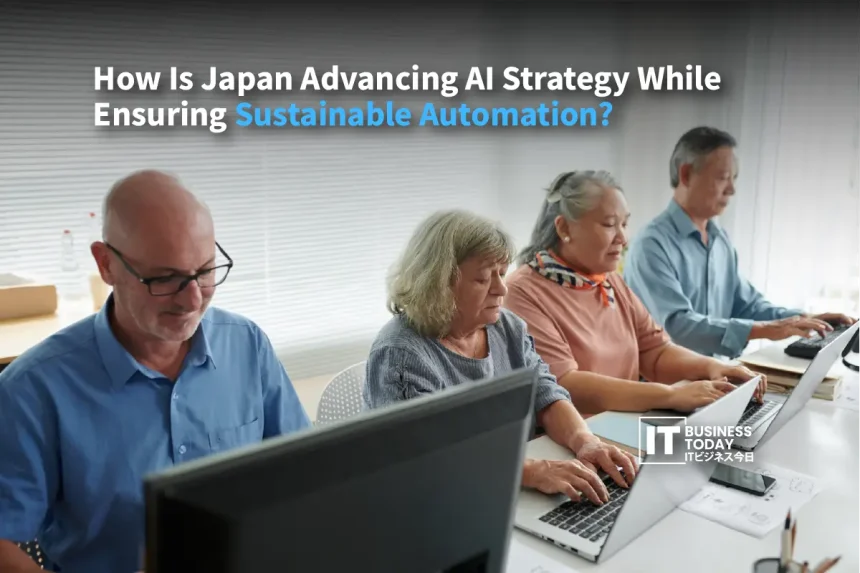技術的破壊に直面する世界のビジネスリーダーにとって、日本は重要なケーススタディです。日本は人口動態の大きな課題に直面しています。高齢化が急速に進み、労働人口が減少しているのです。2023年9月時点で、65歳以上の高齢者は日本の人口の29.1%を占め、合計で 3620万ドル 個人。それでも、日本は人工知能のリーダーとしての地位を大胆に主張しています。東京や大阪などの役員室での重要な質問は、日本が自動化を行うかどうかだけではありません。どのように責任を持ってそれを行うかということです。つまり、重要な価値観に沿った進歩を確保することです。日本のAI戦略には3つの主要目標があります:
- 社会の調和を促進すること。
- 環境を守る
- 長期的な安定性の確保。
これは即効性のある解決策ではなく、長期的な視野に立った入念な計画です。自動化を持続可能なものにするということです。これは、あらゆる企業にとって貴重な教訓となります。
効率を超える
日本の AI 革命は、経費節減や効率化にとどまりません。それは国家の存続と経済的地位の維持です。ほぼ3人に1人が65歳以上。日本の総労働力人口は、2017年の6530万人から減少し、2017年には約100万人になると予測されています。 5,245万ドル 2040年までにつまり、高い生産性と強力な社会サービスを維持することが不可欠なのです。自動化はもはや便利なものではなく、必要なものなのです。日本は、人間の労働力を完全に置き換えることは望ましくなく、持続不可能であると認識しています。ビジョンはオーグメンテーション。現在の労働力を強化するためにAIを活用することです。これにより、人間のスキルが強化され、新たな価値が生まれます。この目標には、最新のアルゴリズムを使用するよりもはるかに複雑な戦略が必要です。
こちらもお読みください: 行動のインターネット:IoTはあなたが考えている以上にどのように追跡しているのか
政府のビジョンと「ソサエティ5.0
日本のアプローチは ソサエティ5.0国も支持する大胆なアイデア。社会 5.0 はソサエティ4.0の次のステップと考えられています。それは、サイバースペースと物理的な世界を融合させること。この新しい社会は、AI、IoT、ロボティクス、ビッグデータを活用。目標は、困難な社会問題に取り組むことです。スマートシティを想像してみてください。ここではAIがエネルギー網を瞬時に改善。予測医療システムは高齢化社会を支援します。また、精密農業は環境を保護しながら作物の収穫量を増やします。政府の AI 戦略目標は、持続可能性のための主要分野を対象としています。エネルギー効率や資源の賢い利用などがその対象です。ヘルスケアの革新やインフラの強靭化も大きな焦点です。この目標は、変化に対応するために定期的に更新されます。研究開発センター、大学とのパートナーシップ、官民共同プロジェクトには公的資金が投入されます。これにより、人々を第一に考えるイノベーションに適した環境が構築されるのです。
産業界の動き
丁寧なものづくりで知られる日本企業。彼らは今、この国家的ビジョンを実際のビジネス手法に変えようとしています。その焦点は、持続可能な統合です:
- 製造業ルネッサンス: トヨタとファナックが協働ロボット(コボット)とAIを活用した予知保全でリード。目標は単に組立ラインの高速化だけではありません。ダウンタイムゼロ」の工場と、超効率的な資源の活用です。AIは何千台もの機械からデータを分析。故障を事前に予測します。これにより、無駄を省き、生産時のエネルギー使用を最適化することができます。AIの「カイゼン」アプローチは、生産性を向上させ、環境への影響を継続的に削減するのに役立ちます。
- プレスの問題に対する精密ソリューション: 富士通はAIを活用してデータセンターの冷却を改善し、その冷却システムによってエネルギー消費を最大で削減しました。 40%. これは、AIが成長するにつれてより多くの電力を必要とするため、重要なことです。三菱電機はスマートビルのエネルギー管理システムにAIを使用しています。これは効率的でインテリジェントな都市空間の創造に役立ちます。農業では、スプレッドのような企業が屋内垂直農園で先導しています。これらの農場は完全に自動化され、AIによって制御されています。光、栄養素、水をスマートアルゴリズムで管理。従来の農業に比べ、1平方メートルあたり数百倍の収量を達成します。さらに、使用する資源もはるかに少なくて済みます。
- 人間中心のオートメーション: 差別化のポイントは、日本がAIを代替ではなくパートナーとして重視していること。三菱UFJフィナンシャル・グループは、不正行為の検知やリスク評価にAIを活用しています。これにより、人間のスタッフは複雑な顧客関係に集中することができます。そして、パーソナライズされたファイナンシャル・アドバイスを提供することができます。AI診断は医師を助けています。作業負担を軽減し、精度を高めます。特に高齢者の多い地域では有効です。単に医師が足りないだけなのです。目標は人間の判断力と共感力を高めることであり、それに取って代わることではありません。
倫理の羅針盤
自動化を持続可能なものにするために、日本は国民の信頼を築かなければなりません。雇用の喪失、偏ったアルゴリズム、不透明な意思決定プロセス。そこで日本は、倫理的なAIを戦略の中核に据えました。
政府の「人間中心AIの社会的原則」は、以下の点に焦点を当てています:
- 公平性
- 透明性
- 説明責任
- プライバシー
業界コンソーシアムは、責任あるAIの開発と展開のためのガイドラインを積極的に開発しています。説明可能なAI」(XAI)についての議論は一般的です。人々がアルゴリズムによる決定を理解し、疑問を持つことができることが重要です。これは、雇用、融資、医療診断のような重要な分野で特に当てはまります。倫理的ガバナンスへのコミットメントは、イノベーションをサポートします。それは、AIソリューションが有用であり、すべての人に受け入れられることを確実にする重要な基盤です。
シナジーのためのスキルアップ

持続可能なAIの未来には、インテリジェントな機械とともに成長するための労働力が必要です。日本は、人間の労働力が容易に適応できるときに自動化が最もうまく機能することを知っています。大規模な再教育とスキルアップの取り組みに多額の投資が行われています。政府のプログラムは企業や学校と提携しています。AIリテラシー、データ分析、AIシステムを管理するためのスキルに関するコースを設けています。企業は社内でトレーニング・アカデミーを立ち上げています。企業は、AIツールを新しい方法で活用できる労働力が最大の資産であることを知っているからです。物語は変わりつつあります。代替を恐れる代わりに、人々は増強によって力を得ています。この変化は、AIの監督、倫理的監査、データ戦略、人間と機械のコラボレーションの構築など、新たな仕事をもたらします。雇用主は、次のような仕事の間を埋める人材の育成と再教育に重点を置くことから始めるべきです。 1100万人と1200万人 2030年までに日本が必要とするであろう新たなポジション。
課題を克服する
この道程に障害がないわけではありません。一部の伝統的な企業の変化がいかに遅いかという懸念が続いています。これは、より大きなデジタル格差につながる可能性があります。中小企業は日本経済にとって不可欠です。中小企業がAIの恩恵を受けるためには、明確なサポートとシンプルなソリューションが必要です。迅速なイノベーションと強固な倫理的ルールの両立には、不断の監視と柔軟な規制が必要です。AI人材のグローバルな獲得競争は厳しい。そのため、優秀な研究者やエンジニアにとって魅力的な環境を作る必要があります。
日本のビジネスリーダーのための実践的洞察

日本のユニークなアプローチは、AIの持続可能な活用を目指すビジネスリーダーに明確な教訓を与えてくれます。
- ソサエティ5.0のマインドセット:有意義で長期的な関係を築き、親愛の情を大切に。AIが社会の大きな課題の解決にどのように役立つかを探求してください。例えば
- 生態系の保護
- 医療をより身近に
- より良い都市空間の構築
このアプローチは、あなたのビジネスにも価値をもたらします。
- 人間とAIのパートナーシップを優先:人間に逆らわず、人間とともに働くAIシステムを設計しましょう。人材育成に投資しましょう。これにより、人とAIの両方の強みを活かすことができます。AIはデータ分析に優れています。しかし、人間にはAIには真似できない独自の判断力、創造力、共感力があります。
- AI開発における倫理:人工知能の開発と使用に関する明確なルールを設定。透明性、説明のしやすさ、ユーザーの信頼の構築に重点を置きましょう。今日の重要なリソースを守るために、倫理審査委員会の設置を考えてください。説明責任の確保に役立ちます。
- 持続可能な効率化を目指して:AIで資源を最適化し、無駄を省き、エネルギー効率を高めます。競争力を維持し、グローバルなESG目標を達成するには、この重要なステップが必要です。AIがどのようにサプライチェーン管理を変え、予知保全を改善し、エネルギー使用を最適化できるかをご覧ください。
- 戦略的提携:大学、研究チーム、業界団体、競合他社と協力し、困難な持続可能性に取り組みます。 課題.協力することで、革新的なソリューションを開発することができます。政府プログラムを活用して重要なリソースを見つけ、AIコミュニティを強化しましょう。
- 実用的で先見性のあるアプローチ:予知保全やAIを活用した顧客サービスなど、重要な課題に取り組む集中的なパイロットプロジェクトを開始。価値を示し、そこから学び、成長すること。AIを活用した変化と持続可能性を実現するための長期的なビジョンを構築してください。
結論
日本がリード AI 最新のテクノロジーと重要な価値を組み合わせることによって。重要な価値観とは、持続可能性、社会的福利、そして人間の尊厳です。それは、人間、倫理、テクノロジーを別個のものではなく、つながったものとして捉えることです。日本のAIのアプローチが、イノベーションにおいて人間を第一に考えることに重点を置いているのはこのためです。これにより、高度な研究開発への投資が促進されます。また、労働力の変革にもつながります。また、日本は持続可能な成果を達成するために自動化を活用しています。このアプローチは、多くの国に影響を与える進歩のモデルを作り出します。
日本のビジネスリーダーは、AIを単なる効率化の道具としてではなく、変革の力として捉えるべきです。変革の力として捉えるべきです。この転換は、知恵と責任によって導かれるべきです。目標は、収益性が高く、強いビジネスを構築することです。従業員、顧客、地域社会、そして地球。日本はイノベーションと誠実さでリードすることを目指しています。オートメーションが人々を助け、持続可能である未来を目指しています。日本の日の出 AI戦略 は、築く価値のある未来に光を当てます。







